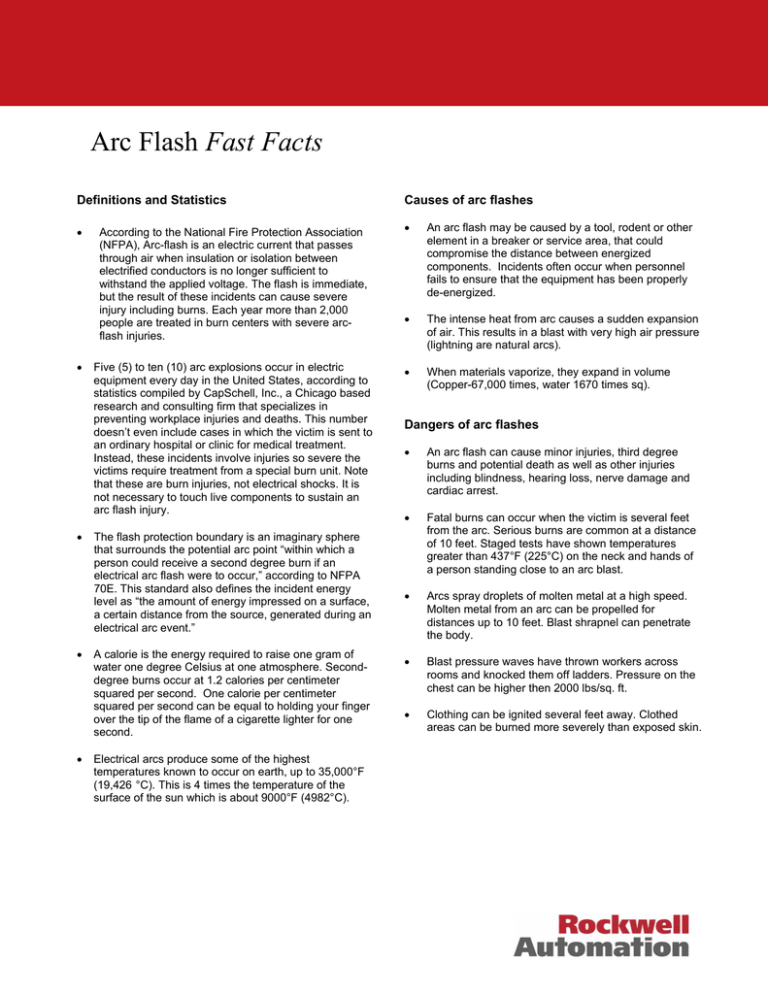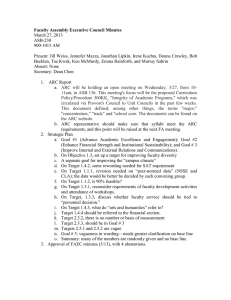
Arc Flash Fast Facts
Definitions and Statistics
Causes of arc flashes
•
•
An arc flash may be caused by a tool, rodent or other
element in a breaker or service area, that could
compromise the distance between energized
components. Incidents often occur when personnel
fails to ensure that the equipment has been properly
de-energized.
•
The intense heat from arc causes a sudden expansion
of air. This results in a blast with very high air pressure
(lightning are natural arcs).
•
When materials vaporize, they expand in volume
(Copper-67,000 times, water 1670 times sq).
•
•
•
•
According to the National Fire Protection Association
(NFPA), Arc-flash is an electric current that passes
through air when insulation or isolation between
electrified conductors is no longer sufficient to
withstand the applied voltage. The flash is immediate,
but the result of these incidents can cause severe
injury including burns. Each year more than 2,000
people are treated in burn centers with severe arcflash injuries.
Five (5) to ten (10) arc explosions occur in electric
equipment every day in the United States, according to
statistics compiled by CapSchell, Inc., a Chicago based
research and consulting firm that specializes in
preventing workplace injuries and deaths. This number
doesn’t even include cases in which the victim is sent to
an ordinary hospital or clinic for medical treatment.
Instead, these incidents involve injuries so severe the
victims require treatment from a special burn unit. Note
that these are burn injuries, not electrical shocks. It is
not necessary to touch live components to sustain an
arc flash injury.
The flash protection boundary is an imaginary sphere
that surrounds the potential arc point “within which a
person could receive a second degree burn if an
electrical arc flash were to occur,” according to NFPA
70E. This standard also defines the incident energy
level as “the amount of energy impressed on a surface,
a certain distance from the source, generated during an
electrical arc event.”
A calorie is the energy required to raise one gram of
water one degree Celsius at one atmosphere. Seconddegree burns occur at 1.2 calories per centimeter
squared per second. One calorie per centimeter
squared per second can be equal to holding your finger
over the tip of the flame of a cigarette lighter for one
second.
Electrical arcs produce some of the highest
temperatures known to occur on earth, up to 35,000°F
(19,426 °C). This is 4 times the temperature of the
surface of the sun which is about 9000°F (4982°C).
Dangers of arc flashes
•
An arc flash can cause minor injuries, third degree
burns and potential death as well as other injuries
including blindness, hearing loss, nerve damage and
cardiac arrest.
•
Fatal burns can occur when the victim is several feet
from the arc. Serious burns are common at a distance
of 10 feet. Staged tests have shown temperatures
greater than 437°F (225°C) on the neck and hands of
a person standing close to an arc blast.
•
Arcs spray droplets of molten metal at a high speed.
Molten metal from an arc can be propelled for
distances up to 10 feet. Blast shrapnel can penetrate
the body.
•
Blast pressure waves have thrown workers across
rooms and knocked them off ladders. Pressure on the
chest can be higher then 2000 lbs/sq. ft.
•
Clothing can be ignited several feet away. Clothed
areas can be burned more severely than exposed skin.
Standards
Arc Flash Safety and Prevention
•
•
Arc flash analysis must be performed prior to
allowing personnel to work on energized
equipment. The analysis defines the flash
protection boundary distance and the type of
Personal Protection Equipment (PPE) required.
•
OSHA is an enforcer of safety practices in
workplaces within the United States. OSHA
1910.132 (d) and 1926.28(a) states that the
employer is responsible to assess the hazards in
the work place, and to select, have and use
correct PPE and document the assessment. The
employer is required to conduct hazard
assessment in accordance with
29CFR1910.132(d)(1). Employers who conduct
the hazard/risk assessment, and select and
require their employees to use PPE, as stated in
the NFPA 70E standard, 2004 edition, are
deemed in compliance with the Hazard
Assessment and Equipment Selection OSHA
Standard.
•
The most common and industry accepted
Personal Protective Equipment is flame resistant
(FR) clothing.
•
Use arc resistant equipment such as the
Centerline ArcShield from Rockwell Automation
for a higher level of employee protection.
Four separate industry standards establish practices
for the prevention of arc flash incidents in the United
States:
•
OSHA 29 Code of Federal Regulations (CFR)
Part 1910, Subpart S (Addresses standards
for work practices)
NFPA 70-2005, National Electric Code
(contains requirements for warning labels)
NFPA 70E-2004, Standard for Electrical
Safety Requirements for Employee
Workplaces (provides guidance on
implementing appropriate work practices that
are required to safeguard workers from injury
while working on or near exposed electrical
conductors or circuit parts that could become
energized)
IEEE Standard 1584-2002, Guide for
Performing Arc Flash Hazard Calculations
The NFPA 70E standard is a comprehensive standard
that contains detailed information on how to protect
workers from the heat of electric arc exposures.
Preventative maintenance, worker training, and an
effective safety program can significantly reduce arc
flash exposure.
Costs
•
Arc flashes can destroy equipment causing extensive
downtime and requiring costly replacement and repair.
•
Treatment for the injured worker can be very costly.
This does not include significant litigation fees,
insurance increases, fines, accident investigation, etc.
The arc flash information contained in this document
was compiled using information from the National
Fire Protection Association (NFPA), ESA’s Practical
Solution Guide to Arc Flash Hazard, and an article in
EC&M magazine (Electrical Construction &
Maintenance) Preventing Arc Flash Incidents in the
Workplace, by George Gregory, 2003.
Medium Voltage Products, 135 Dundas Street, Cambridge, ON, N1R 5X1 Canada, Tel: (1) 519.740.4100, Fax: (1) 519.623.8930, www.ab.com/mvb
Publication 1500-WP001A-EN-E – January 2005
Copyright © 2005 Rockwell Automation. All rights reserved. Printed in Canada.



